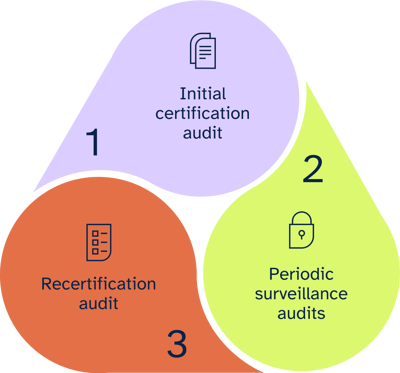What is an ISMS audit?
An ISMS audit, or Information Security Management System audit, is a systematic review of an organization's information security practices and controls. It is conducted to assess the effectiveness of the organization's security management system and ensure adherence to international standards, such as ISO/IEC 27001. An ISMS audit helps identify security weaknesses, risks, and areas for improvement, both in terms of processes and documentation. It involves evaluating the security posture of the organization, including its security objectives, policies, procedures, and practices. The audit process typically includes activities such as documentation review, management reviews, field reviews, and gap analysis. The audit findings are documented in an audit report, which highlights key findings and recommendations for corrective actions. The ultimate goal of an ISMS audit is to help organizations strengthen their security controls, minimize security risks, and maintain a competitive advantage in today's digital landscape.
Benefits of an ISMS audit
An ISMS audit offers several benefits to organizations aiming to conform with ISO 27001 requirements. Firstly, it provides proactive assurance that the management system and processes are aligned with the standard's criteria. This helps organizations identify any gaps or deficiencies early on, allowing for timely corrective actions and minimizing risks.
Additionally, an ISMS audit ensures effective communication and understanding of processes throughout the organization. By conducting regular audits, organizations can review and assess their security practices, ensuring that all employees are aware of their roles and responsibilities in maintaining a secure environment.
Furthermore, ISMS audits help identify non-conformities to ISO 27001 requirements. These audits pinpoint weaknesses or areas where processes are not aligned with the standard, allowing organizations to address these issues promptly. By resolving non-conformities, organizations can enhance their security posture and reduce the likelihood of security incidents.
Lastly, ISMS audits offer opportunities for improvement. By examining their processes and controls, organizations can identify areas for enhancement and implement action plans to address them. This continual improvement helps organizations stay vigilant and adapt to evolving security risks and challenges.
Types of audits
There are various types of audits that organizations can conduct to assess the effectiveness and compliance of their Information Security Management Systems (ISMS). These audits can provide valuable insights into the organization's security practices and help identify areas for improvement. The most common types of audits include internal audits, external audits, and certification audits.
Internal audits are conducted by internal auditors who are part of the organization. These audits ensure that the organization's security controls and processes are functioning as intended and are aligned with the ISO 27001 standard. Internal audits are conducted regularly and provide an opportunity for organizations to identify any non-conformities or areas for improvement.
External audits involve independent auditors who assess the organization's ISMS against the ISO 27001 standard. These audits are usually conducted by a certification body to determine if the organization meets the requirements for certification. External audits provide an unbiased evaluation of the organization's security practices and help maintain the credibility of the certification.
Certification audits are conducted to assess whether an organization meets the ISO 27001 requirements and is eligible for certification. These audits are thorough and comprehensive, covering all aspects of the ISMS. Certification audits are typically conducted by certification bodies and result in the organization attaining ISO 27001 certification.
Discover the audit and assessment capability within 6clicks to streamline audit and remediation processes.
Initial certification audit
The initial certification audit is an essential part of the process for organizations seeking ISO 27001 certification. Conducted by an accredited certification body, this audit is the first step towards assessing the organization's compliance with the ISO 27001 standard.
The initial certification audit follows a two-step review process. The first step involves a documentation review, where the certification body evaluates the organization's ISMS documentation to ensure it meets the requirements of ISO 27001. This review assesses the organization's policies, procedures, and controls in place to manage information security risks.
If the organization successfully passes the documentation review, the second step involves an on-site audit. During this audit, the certification body examines the organization's information security practices in action. This includes evaluating the implementation and effectiveness of security controls, assessing security risks, and reviewing business processes.
Upon successful completion of the two-step review process, the certification body may award the organization with ISO 27001 certification. This certification is valid for three years, during which periodic surveillance audits are conducted to ensure continued compliance.
The initial certification audit is a crucial step for organizations seeking to demonstrate their commitment to information security and gain a competitive advantage in the market. By achieving ISO 27001 certification, organizations can enhance their security posture, mitigate security risks, and assure their stakeholders of their dedication to protecting information assets.
Periodic surveillance audits
Periodic surveillance audits are an essential part of maintaining ISO 27001 certification. These audits are conducted by the certification body at regular intervals throughout the three-year certification period. The purpose of these audits is to ensure that the organization's information security management system (ISMS) continues to meet the requirements of ISO 27001 and remains effective in managing information security risks.
During a surveillance audit, the certification body reviews various aspects of the organization's ISMS to ensure ongoing compliance. This includes assessing the implementation and effectiveness of security controls, reviewing business processes, and evaluating the organization's security posture. The audit team focuses on key areas identified during previous audits and any changes within the organization that may impact the ISMS.
The audit team gathers evidence through interviews, document reviews, and observations to evaluate the organization's adherence to ISO 27001 requirements. They may also conduct field reviews, where they assess the organization's security practices in real-world scenarios. The audit team then submits a report to the organization, detailing the findings of the audit, including any nonconformities identified.
Nonconformities are instances where the organization's ISMS does not meet the requirements of ISO 27001. These can be minor nonconformities that require corrective actions, or major nonconformities that may jeopardize the organization's ISO 27001 certification. The organization is required to address these nonconformities within a specified timeframe and provide evidence of corrective actions taken.
By conducting periodic surveillance audits, organizations can demonstrate their commitment to maintaining a robust ISMS and meeting the requirements of ISO 27001. This process helps ensure ongoing compliance and provides assurance to stakeholders that the organization continues to prioritize information security.
Recertification audit
A recertification audit for an Information Security Management System (ISMS) is conducted after three years of initial certification. Its purpose is to ensure ongoing compliance with ISO 27001 requirements and assess the effectiveness of the organization's ISMS.
The recertification audit involves a thorough review of the organization's nonconformities identified during previous audits. The audit team also evaluates the overall effectiveness of the ISMS, including its policies, procedures, controls, and corrective/preventive actions. Additionally, they review the organization's internal audits and management reviews to assess the continuous improvement of the ISMS.
The scope and appropriateness of the certification are also examined during the recertification audit. This includes verifying that the certification still aligns with the organization's current business goals and objectives.
By conducting a recertification audit, the organization demonstrates its commitment to maintaining a robust ISMS and continuously improving its information security practices. Adhering to the audit process and addressing any nonconformities identified ensures the organization's ongoing compliance with ISO 27001 requirements.
Explore the 6clicks solution to quickly and easily implement your ISMS based on ISO 27001.
Preparing for the ISMS audit
Before undergoing an ISMS audit, it is essential for organizations to adequately prepare to ensure a successful evaluation of their security management system. This preparation involves several key steps to ensure that the audit process runs smoothly and efficiently. First, the organization should carefully review and familiarize themselves with the audit criteria and requirements of the relevant ISO standard, such as ISO/IEC 27001. This includes understanding the specific security controls and policies that need to be in place and ensuring compliance with international standards. Next, the organization should conduct a thorough gap analysis to identify any areas of weakness or nonconformities that need to be addressed before the audit. This analysis helps to identify potential risks and vulnerabilities and determine the necessary corrective actions to improve security practices. Additionally, the organization should establish and maintain appropriate documentation that demonstrates compliance with the standard requirements. This includes developing policies, procedures, and records that clearly outline the security objectives and processes. Finally, conducting internal audits can help to identify any areas that may need improvement and ensure that the ISMS is functioning effectively before the formal certification audit. By taking these steps, organizations can ensure that they are well-prepared for the ISMS audit and increase their chances of achieving certification.
Understanding the scope and objectives of the audit
Understanding the scope and objectives of an ISMS (Information Security Management System) audit is crucial for effectively assessing the security posture of an organization. The scope of the audit refers to the information systems and assets that will be included in the assessment. This can range from networks and servers to databases and applications. The objectives of the audit are to identify security risks, assess the effectiveness of security controls, and identify areas for improvement.
To ensure a thorough audit, it is important to create an audit plan. The audit plan outlines the activities to be performed, the timeline, and the resources required. It also helps in confirming the relevant clauses and controls based on ISO 27001:2013, the international standard for information security management. This ensures that the audit is aligned with industry best practices and regulations.
Selecting an impartial internal auditor is essential for an unbiased assessment. The auditor should have a deep understanding of the ISO 27001 standard, as well as the organization's information security policies and procedures. They should be independent and free from any conflicts of interest. It is also important that the auditor possesses appropriate qualifications and experience in conducting ISMS audits.
Establishing a documented system and processes
Establishing a documented system and processes is an essential step in ensuring an effective ISMS audit. This involves creating and implementing the necessary documentation required to meet the requirements of ISO 27001:2013, the international standard for information security management.
The first step in this process is to develop a comprehensive set of ISO 27001 documents, which serve as the foundation for the audit. These documents should include the Statement of Applicability (SoA), which identifies the scope of the ISMS and the security controls that are applicable to the organization. The Risk Treatment Plan (RTP) should also be included, outlining the risk assessment and risk treatment methodologies used by the organization. Additionally, an Information Security Policy (ISP) needs to be developed, stating the organization's commitment to information security and providing guidelines for implementing and maintaining the ISMS.
Once these documents are developed, they need to be reviewed and approved by management. This ensures that the documentation accurately reflects the organization's information security practices and aligns with industry standards. It is important to involve key stakeholders and subject matter experts in this review process to ensure that all perspectives are taken into consideration.
After management approval, the documents need to be made accessible to all staff. This may involve creating a centralized document management system or using an online portal to ensure easy access and retrieval. It is crucial that all staff members are aware of the documentation and understand their roles and responsibilities in implementing the ISMS.
Implementing security controls and practices
Implementing security controls and practices in an ISMS audit involves a structured process that ensures the protection of sensitive information and mitigation of cybersecurity threats. This process can be broken down into several key steps.
First, organizations need to identify the security controls that are relevant and applicable to their ISMS. This includes conducting a risk assessment to identify potential security risks and vulnerabilities. Once identified, controls can be put in place to address these risks and protect sensitive information.
Next, organizations need to establish effective controls in key areas such as identity and access management, change and configuration management, incident management, business continuity and disaster recovery, and third-party/vendor management. This involves defining policies, procedures, and guidelines for each area and implementing technical solutions to enforce these controls.
To ensure the effectiveness of these controls, organizations need to regularly monitor and evaluate their implementation. This includes conducting internal audits and periodic assessments to identify any gaps or weaknesses in the controls. Any findings should be addressed through corrective actions to continually improve the effectiveness of the controls.
Finally, organizations need to maintain documentation and records of their security controls and practices. This includes documenting policies, procedures, and guidelines, as well as maintaining records of audits, assessments, and incidents. This documentation allows organizations to demonstrate compliance with standards and regulations and provides a reference for future audits and assessments.
Evaluating internal risk management procedures
Evaluating internal risk management procedures is a crucial component of an ISMS audit, as it serves to identify any non-conformities and enhance the overall effectiveness of the Information Security Management System (ISMS). By conducting a comprehensive evaluation, organizations can proactively identify, assess, and mitigate potential risks to their sensitive information.
The first step in evaluating internal risk management procedures is conducting a thorough risk assessment. This involves identifying and prioritizing risks that may impact the confidentiality, integrity, and availability of information. By analyzing the probability and potential impact of each risk, organizations can determine the appropriate controls and measures needed to mitigate them effectively.
Once risks have been identified, organizations need to implement controls and measures to address them. This may involve defining policies, procedures, and guidelines that outline how the risks will be managed and ensuring that appropriate technical solutions are in place. Regularly reviewing and updating these controls is essential to adapt to changing security threats and ensure their ongoing effectiveness.
Continuous monitoring and reviewing of internal risk management procedures are imperative to identify any emerging risks and potential non-conformities. Regular internal audits can help identify any gaps or weaknesses in the controls, allowing organizations to implement corrective actions promptly. By systematically assessing and addressing these findings, organizations can continuously improve their risk management procedures and enhance the overall security posture of their ISMS.
Assessing external risks and potential threats
Assessing external risks and potential threats is a crucial component of an ISMS audit. It involves a systematic evaluation of the external factors that may pose risks to an organization's information security.
To begin, organizations need to identify and evaluate external risks that could impact their ISMS. These risks can arise from various sources, such as technological advancements, changes in regulations or industry standards, emerging cyber threats, or geopolitical factors. It is essential to conduct thorough research and analysis to identify these risks accurately.
Once identified, the next step is to evaluate the potential impact of these external risks on the organization's information security. This involves assessing the likelihood of these risks occurring and the potential consequences if they were to materialize. The evaluation should take into account the sensitivity and criticality of the information assets, the potential financial and reputational impact, as well as any legal or regulatory implications.
During the assessment process, it is essential to consider various aspects, such as the organization's current security controls, existing vulnerabilities, and the capability to detect and respond to external threats. This can be achieved through activities such as vulnerability scanning, penetration testing, threat intelligence analysis, and reviewing incident response plans.
By conducting a thorough assessment of potential external threats and their impact, organizations can develop effective strategies to mitigate these risks. This may involve implementing additional security measures, revising security policies and procedures, or establishing contingency plans to address potential breaches or disruptions.
Conducting the ISMS audit
Conducting the ISMS audit is a crucial step in ensuring the effectiveness and compliance of an organization's information security management system. The audit assesses the organization's adherence to relevant international standards, such as ISO/IEC 27001, and evaluates the implementation and effectiveness of the controls and processes established in the ISMS. The audit provides invaluable insights into the organization's security posture, identifies any weaknesses or gaps in the system, and highlights opportunities for improvement. It involves a comprehensive review of documentation, interviews with key personnel, and an evaluation of the organization's security practices and procedures. By conducting regular ISMS audits, organizations can proactively address security risks, demonstrate their commitment to information security, and maintain a competitive advantage in today's rapidly evolving threat landscape.
Developing an audit plan and program
Developing an audit plan and program for an ISMS (Information Security Management System) audit is crucial to ensure a systematic and thorough assessment of an organization's security controls and processes. The Lead Auditor plays a crucial role in developing and managing the audit plan.
The Lead Auditor should start by preparing an annual internal audit program that outlines the schedule and objectives of the audits to be conducted throughout the year. This program should be regularly revised as needed to reflect changes in the organization's security risks and business processes.
The audit plan itself should include several key components. Firstly, the audit objective and scope should be clearly defined to ensure that a focused and comprehensive assessment is conducted. Secondly, the plan should identify the responsible individuals who will participate in the audit and their specific roles and responsibilities. It is also important to establish an audit team that possesses the necessary expertise and knowledge to effectively evaluate the organization's security controls.
Additionally, the audit plan should outline the timeline for conducting fieldwork and reporting. This includes setting deadlines for gathering evidence, conducting interviews, and analyzing findings. It is essential to allocate sufficient time for thorough evaluation to ensure accurate and meaningful results. The plan should also include a timeline for the preparation and submission of the audit report.
Overall, developing an audit plan and program for an ISMS audit requires careful planning and coordination. With a well-defined audit objective and scope, the involvement of responsible individuals and a competent audit team, and a clear timeline for fieldwork and reporting, organizations can effectively assess their security posture and identify areas for improvement.
Gathering information from stakeholders
Gathering information from stakeholders is a critical step in conducting an ISMS (Information Security Management System) audit. By involving relevant stakeholders in the audit process, organizations can ensure a comprehensive evaluation of their security practices and effectively address potential risks and vulnerabilities.
To begin, auditors need to identify and engage the right stakeholders. These individuals or groups may include key personnel responsible for information security, department heads, process owners, IT teams, and employees who handle sensitive data. Engaging external stakeholders such as customers or suppliers may also be necessary in certain cases.
Once stakeholders are identified, auditors should establish open lines of communication to obtain their input and feedback. This can be done through various methods such as interviews, surveys, or workshops. Auditors should create an environment that encourages stakeholders to share their perspectives, insights, and concerns regarding the organization's security controls and practices.
It is important to emphasize the significance of collaboration throughout the audit process. This can be achieved by involving stakeholders in planning discussions, providing regular updates on audit progress, and seeking their input on findings and recommendations. Open communication helps to foster a sense of ownership and accountability among stakeholders, increasing the likelihood of successful implementation of corrective actions and continual improvement of the ISMS.
Written by Andrew Robinson
Andrew started his career in the startup world and went on to perform in cyber and information security advisory roles for the Australian Federal Government and several Victorian Government entities. Andrew has a Masters in Policing, Intelligence and Counter-Terrorism (PICT) specialising in Cyber Security and holds IRAP, ISO 27001 LA, CISSP, CISM and SCF certifications.










